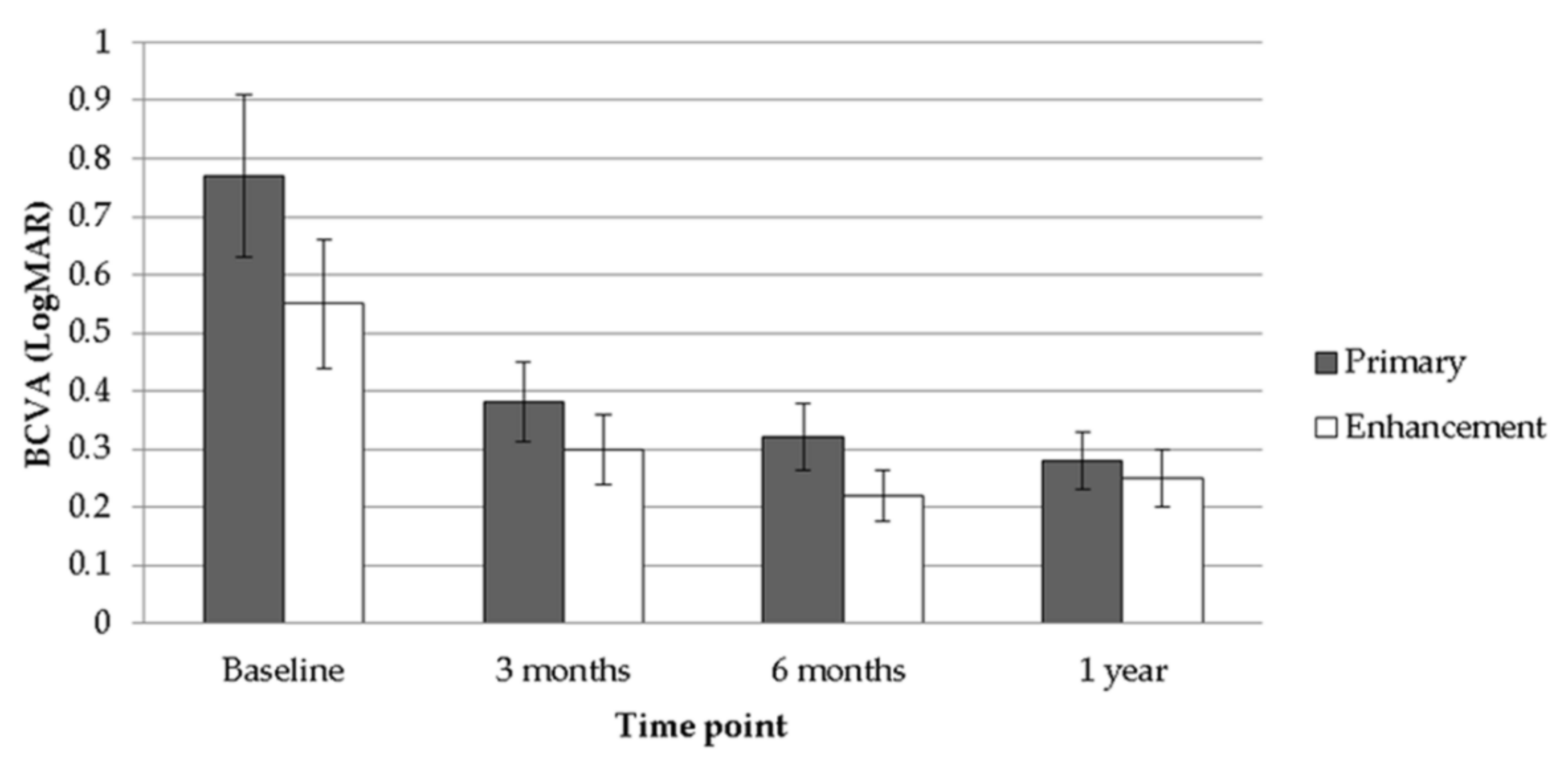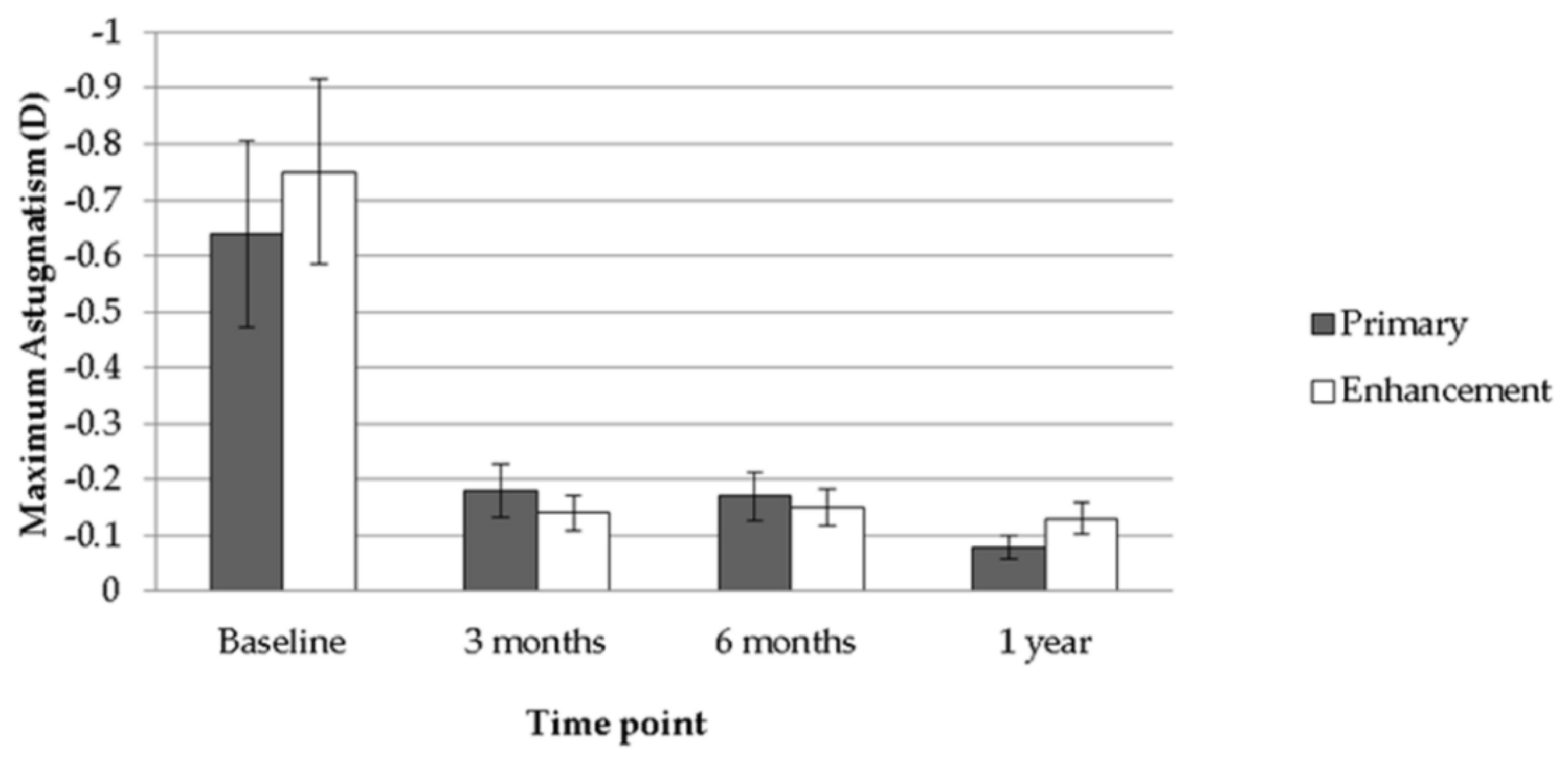Correction of Myopic Astigmatism with Topography-Guided Laser In Situ Keratomileusis (TOPOLINK)
Abstract
:1. Introduction
2. Materials and Methods
2.1. Ethics Declaration
2.2. Subject Selection
2.3. Surgery Technique
2.4. Main Outcome Measures
2.5. Statistical Analysis
3. Results
3.1. Patient Characteristics
3.2. Visual Outcomes and Refractive Status in the Primary and Enhancement TOPOLINK
3.3. Patient Satisfaction
4. Discussion
5. Conclusions
Author Contributions
Funding
Acknowledgments
Conflicts of Interest
References
- Read, S.A.; Collins, M.J.; Carney, L.G. A review of astigmatism and its possible genesis. Clin. Exp. Optom. 2007, 90, 5–19. [Google Scholar] [CrossRef]
- Davis, E.A.; Lindstrom, R.L. Astigmatism management: Ablation patterns. Curr. Opin. Ophthalmol. 2001, 12, 300–303. [Google Scholar] [CrossRef] [PubMed]
- Farbrother, J.E.; Welsby, J.W.; Guggenheim, J.A. Astigmatic axis is related to the level of spherical ametropia. Optom. Vis. Sci. 2004, 81, 18–26. [Google Scholar] [CrossRef] [PubMed] [Green Version]
- Fan, D.S.; Rao, S.K.; Cheung, E.Y.; Islam, M.; Chew, S.; Lam, D.S. Astigmatism in chinese preschool children: Prevalence, change, and effect on refractive development. Br. J. Ophthalmol. 2004, 88, 938–941. [Google Scholar] [CrossRef] [PubMed] [Green Version]
- Abrahamsson, M.; Sjöstrand, J. Astigmatic axis and amblyopia in childhood. Acta Ophthalmol. Scand. 2003, 81, 33–37. [Google Scholar] [CrossRef] [PubMed]
- Goggin, M.; Alpins, N.; Schmid, L.M. Management of irregular astigmatism. Curr. Opin. Ophthalmol. 2000, 11, 260–266. [Google Scholar] [CrossRef] [PubMed]
- Ghoreishi, M.; Naderi Beni, A.; Naderi Beni, Z. Visual outcomes of topography-guided excimer laser surgery for treatment of patients with irregular astigmatism. Lasers Med. Sci. 2014, 29, 105–111. [Google Scholar] [CrossRef]
- Read, S.A.; Vincent, S.J.; Collins, M.J. The visual and functional impacts of astigmatism and its clinical management. Ophthalmic Physiol. Opt. 2014, 34, 267–294. [Google Scholar] [CrossRef] [Green Version]
- Schallhorn, S.C.; Tanzer, D.J.; Kaupp, S.E.; Brown, M.; Malady, S.E. Comparison of night driving performance after wavefront-guided and conventional lasik for moderate myopia. Ophthalmology 2009, 116, 702–709. [Google Scholar] [CrossRef]
- Aslanides, I.M.; Kolli, S.; Padroni, S.; Arba Mosquera, S. Stability of therapeutic retreatment of corneal wavefront customized ablation with the schwind cam: 4-Year data. J. Refract. Surg. 2012, 28, 347–352. [Google Scholar] [CrossRef]
- Kanjani, N.; Jacob, S.; Agarwal, A.; Agarwal, A.; Agarwal, S.; Agarwal, T.; Doshi, A.; Doshi, S. Wavefront- and topography-guided ablation in myopic eyes using zyoptix. J. Cataract. Refract. Surg. 2004, 30, 398–402. [Google Scholar] [CrossRef] [PubMed]
- Wang, T.J.; Lin, Y.H.; Chang, D.C.; Chou, H.C.; Wang, I.J. Comparison of the effects of cylindrical correction with and without iris recognition technology in wavefront laser-assisted in situ keratomileusis. Clin. Exp. Ophthalmol. 2012, 40, 239–246. [Google Scholar] [CrossRef] [PubMed]
- Kermani, O.; Schmiedt, K.; Oberheide, U.; Gerten, G. Topographic- and wavefront-guided customized ablations with the nidek-ec5000cxii in lasik for myopia. J. Refract. Surg. 2006, 22, 754–763. [Google Scholar] [CrossRef] [PubMed]
- Kanellopoulos, A.J. Topography-guided lasik versus small incision lenticule extraction (smile) for myopia and myopic astigmatism: A randomized, prospective, contralateral eye study. J. Refract. Surg. 2017, 33, 306–312. [Google Scholar] [CrossRef] [PubMed] [Green Version]
- Wu, H.K. Astigmatism and lasik. Curr. Opin. Ophthalmol. 2002, 13, 250–255. [Google Scholar] [CrossRef]
- Toda, I.; Yamamoto, T.; Ito, M.; Hori-Komai, Y.; Tsubota, K. Topography-guided ablation for treatment of patients with irregular astigmatism. J. Refract. Surg. 2007, 23, 118–125. [Google Scholar] [CrossRef]
- Wiesinger-Jendritza, B.; Knorz, M.C.; Hugger, P.; Liermann, A. Laser in situ keratomileusis assisted by corneal topography. J. Cataract. Refract. Surg. 1998, 24, 166–174. [Google Scholar] [CrossRef]
- Knorz, M.C.; Neuhann, T. Treatment of myopia and myopic astigmatism by customized laser in situ keratomileusis based on corneal topography. Ophthalmology 2000, 107, 2072–2076. [Google Scholar] [CrossRef]
- Knorz, M.C.; Jendritza, B. Topographically-guided laser in situ keratomileusis to treat corneal irregularities. Ophthalmology 2000, 107, 1138–1143. [Google Scholar] [CrossRef]
- Dausch, D.; Schroder, E.; Dausch, S. Topography-controlled excimer laser photorefractive keratectomy. J. Refract. Surg. 2000, 16, 13–22. [Google Scholar]
- Koller, T.; Iseli, H.P.; Donitzky, C.; Ing, D.; Papadopoulos, N.; Seiler, T. Topography-guided surface ablation for forme fruste keratoconus. Ophthalmology 2006, 113, 2198–2202. [Google Scholar] [CrossRef] [PubMed]
- Spadea, L.; Bianco, G.; Balestrazzi, E. Topographically guided excimer laser photorefractive keratectomy to treat superficial corneal opacities. Ophthalmology 2004, 111, 458–462. [Google Scholar] [CrossRef] [PubMed]
- Rajan, M.S.; O’Brart, D.P.; Patel, P.; Falcon, M.G.; Marshall, J. Topography-guided customized laser-assisted subepithelial keratectomy for the treatment of postkeratoplasty astigmatism. J. Cataract. Refract. Surg. 2006, 32, 949–957. [Google Scholar] [CrossRef] [PubMed]
- Lee, D.H.; Seo, S.J.; Shin, S.C. Topography-guided excimer laser ablation of irregular cornea resulting from penetrating injury. J. Cataract. Refract. Surg. 2002, 28, 186–188. [Google Scholar] [CrossRef]
- Alio, J.L.; Belda, J.I.; Osman, A.A.; Shalaby, A.M. Topography-guided laser in situ keratomileusis (topolink) to correct irregular astigmatism after previous refractive surgery. J. Refract. Surg. 2003, 19, 516–527. [Google Scholar] [PubMed]
- Reinstein, D.Z.; Gobbe, M.; Archer, T.J.; Youssefi, G.; Sutton, H.F. Stromal surface topography-guided custom ablation as a repair tool for corneal irregular astigmatism. J. Refract. Surg. 2015, 31, 54–59. [Google Scholar] [CrossRef]
- KhabazKhoob, M.; Hashemi, H.; Yazdani, K.; Mehravaran, S.; Yekta, A.; Fotouhi, A. Keratometry measurements, corneal astigmatism and irregularity in a normal population: The tehran eye study. Ophthalmic Physiol. Opt. 2010, 30, 800–805. [Google Scholar] [CrossRef]
- Dougherty, P.J.; Waring, G., 3rd; Chayet, A.; Fischer, J.; Fant, B.; Bains, H.S. Topographically guided laser in situ keratomileusis for myopia using a customized aspherical treatment zone. J. Cataract Refract. Surg. 2008, 34, 1862–1871. [Google Scholar] [CrossRef]





| Demography | Primary Group (n = 18) | Enhancement Group (n = 14) | p Value |
|---|---|---|---|
| Age | 27.10 ± 5.55 | 31.40 ± 7.29 | 0.545 |
| Sex (male: female) | 6:4 | 8:2 | <0.001 * |
| Laterality (right: left) | 9:9 | 8:6 | 0.688 |
| Optic zone (mm) | 6.39 ± 0.27 | 6.07 ± 0.28 | 0.005 * |
| Ablation depth (µm) | 56.06 ± 23.83 | 43.21 ± 15.24 | 0.001 * |
| Parameters | Baseline | 3 Months Postoperative | 6 Months Postoperative | 1 Year Postoperative | p Value |
|---|---|---|---|---|---|
| UCVA (LogMAR, mean ± SD) | 1.55 ± 0.31 A | 0.66 ± 0.27 B | 0.56 ± 0.28 B | 0.55 ± 0.27 B | <0.001 * |
| BCVA (LogMAR, mean ± SD) | 0.77 ± 0.28 A | 0.38 ± 0.25 B | 0.32 ± 0.08 B | 0.28 ± 0.13 B | <0.001 * |
| Maximum astigmatism (D, mean ± SD) | −0.64 ± 0.53 A | −0.18 ± 0.32 B | −0.17 ± 0.10 B | −0.08 ± 0.09 C | <0.001 * |
| SE (D, mean ± SD) | −5.26 ± 1.36 A | −0.69 ± 0.64 B | −0.58 ± 0.39 B | −0.71 ± 0.64 B | <0.001 * |
| Parameters | Baseline | 3 Months Postoperative | 6 Months Postoperative | 1 Year Postoperative | p Value |
|---|---|---|---|---|---|
| UCVA (LogMAR, mean± SD) | 1.10 ± 0.35 A | 0.52 ± 0.27 B | 0.51 ± 0.15 B | 0.51 ± 0.35 B | 0.013 * |
| BCVA (LogMAR, mean± SD) | 0.55 ± 0.30 A | 0.30 ± 0.27 B | 0.22 ± 0.26 B | 0.25 ± 0.16 B | 0.047 * |
| Maximum astigmatism (D, mean± SD) | -0.75 ± 0.90 A | -0.14 ± 0.21 B | -0.15 ± 0.08 B | -0.13 ± 0.08 B | 0.021 * |
| SE (D, mean± SD) | -2.50 ± 2.35 A | -0.41 ± 0.43 B | -0.44 ± 0.13 B | -0.43 ± 0.18 B | 0.033 * |
| Patient Satisfaction | Primary Group (n = 10) | Enhancement Group (n = 10) | p Value |
|---|---|---|---|
| Satisfaction | 0.871 | ||
| Highly satisfied | 60.0% (n = 6) | 70.0% (n = 7) | |
| Moderately satisfied | 30.0% (n = 3) | 20.0% (n = 2) | |
| Not satisfied | 10.0% (n = 1) | 10.0% (n = 1) | |
| Total | 100% (n = 10) | 100% (n = 10) |
Publisher’s Note: MDPI stays neutral with regard to jurisdictional claims in published maps and institutional affiliations. |
© 2020 by the authors. Licensee MDPI, Basel, Switzerland. This article is an open access article distributed under the terms and conditions of the Creative Commons Attribution (CC BY) license (http://creativecommons.org/licenses/by/4.0/).
Share and Cite
Wu, P.-L.; Lee, C.-Y.; Cheng, H.-C.; Lin, H.-Y.; Lai, L.-J.; Wu, W.-C.; Chen, H.-C. Correction of Myopic Astigmatism with Topography-Guided Laser In Situ Keratomileusis (TOPOLINK). Healthcare 2020, 8, 477. https://doi.org/10.3390/healthcare8040477
Wu P-L, Lee C-Y, Cheng H-C, Lin H-Y, Lai L-J, Wu W-C, Chen H-C. Correction of Myopic Astigmatism with Topography-Guided Laser In Situ Keratomileusis (TOPOLINK). Healthcare. 2020; 8(4):477. https://doi.org/10.3390/healthcare8040477
Chicago/Turabian StyleWu, Pei-Lun, Chia-Yi Lee, Han-Chih Cheng, Hung-Yu Lin, Li-Ju Lai, Wei-Chi Wu, and Hung-Chi Chen. 2020. "Correction of Myopic Astigmatism with Topography-Guided Laser In Situ Keratomileusis (TOPOLINK)" Healthcare 8, no. 4: 477. https://doi.org/10.3390/healthcare8040477
APA StyleWu, P.-L., Lee, C.-Y., Cheng, H.-C., Lin, H.-Y., Lai, L.-J., Wu, W.-C., & Chen, H.-C. (2020). Correction of Myopic Astigmatism with Topography-Guided Laser In Situ Keratomileusis (TOPOLINK). Healthcare, 8(4), 477. https://doi.org/10.3390/healthcare8040477






